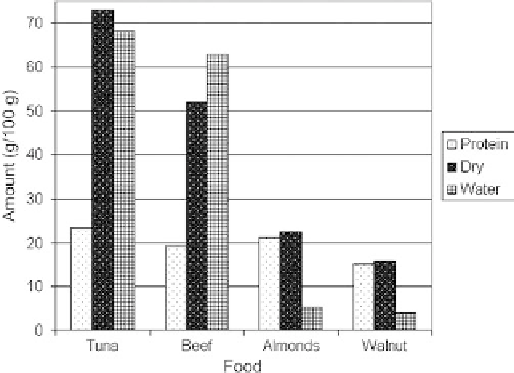Agriculture Reference
In-Depth Information
because the body can make them as long as prerequisite carbon, nitrogen, and sulfur
compounds are present in the diet. These amino acids range from the simplest,
glycine, to more complex amino acids such as arginine.
Essential amino acids are listed in Table 2.4. They are essential because they
cannot be made by the body and must be available in food in order for the body to
obtain them for use in producing muscle, enzymes, and the like. This group of
amino acids ranges from the simple leucine to the multifunctional arginine and the mul-
tiringed tryptophan. Both groups have amino acids with multiple nitrogen-containing
groups and other functionalities such as 22OH, 22SH groups. These groups play key
roles in determining both the shape of proteins and, in the case of some enzymes,
their ability to accommodate metal ions needed for enzymatic activity of enzymes.
The best sources of protein and amino acids are meat and nuts. For example, in
Figure 2.11 it is seen that on a raw-weight basis meat and nuts have about the same
protein content. However, on a dry-weight basis meat has much higher protein content.
This is caused, as can be seen, by meat having much higher water content than nuts.
Thus, when adjusted for water content, that is, on a dry-weight basis, meats have a con-
siderably higher protein content than do nuts. Meat is, for most people, an essential part of
the diet in terms of obtaining enough protein and amino acids for good health.
Tuna and beef, as shown in Figure 2.12, have no carbohydrates or fiber while nuts
do. Nuts have much higher fat content than do meats and also have a much higher
vitamin content on a wet-weight basis, but tuna has about the same amount on a dry-
weight basis. Because they contain little water, nuts have small changes in composition
when calculated on a dry-weight basis. However, they have considerably more fat and
vitamins than beef.
Figure
2.11.
Protein content of selected meats and nuts. (Data from Agricultural Research Ser-
vice Nutrient Data Laboratory USDA National Nutrient Database for Standard Reference,
Release 17, http:
//
www.nal.usda.gov
/
fnic
/
foodcomp
/
Data
/
SR17
/
reports
/
sr17page.htm.)









